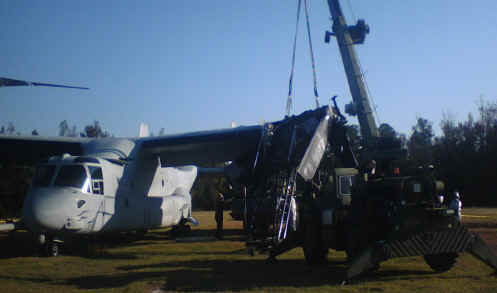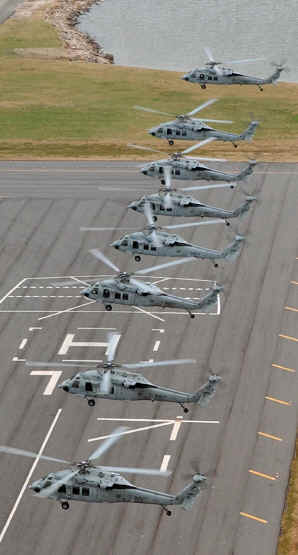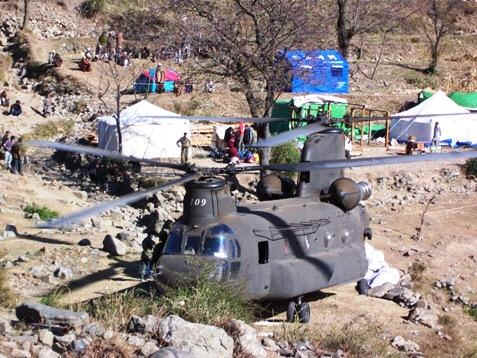I received many questions and answers since publication of "40 MV-22s are Missing!" in July. Some inside the program criticized "wild speculation in the media." This was caused by General Trautman's claim last May that only 91 MV-22s had been delivered to the Marine Corps, a comment that was never corrected or explained. In his testimony, he mouthed gibberish that if the V-22 had been in the force in the 1980s, we wouldn't have problems in Iran today. Not only was that comment insane, it is outright false. The cross-country attempt in 2005 to replicate "Eagle Claw", the failed Iran rescue mission, with V-22s failed miserably, even when they cheated and flew at 14,000 ft rather than 300 ft.
His staff spent two weeks playing games with congressional staff, then finally provided a list of 105 MV-22s in June, with incomplete status information. The Marine public affairs officer said he would provide a list to the media, but never did. The CRS's June 2009 report said Congress had funded 156 MV-22s to the Marines through FY2009. Why not just provide Congress and the media with a complete list of the 156, to include those in production? Since the status of all Marine Corps aircraft is compiled daily, why the reluctance to share the "good" news about the V-22? This reluctance to provide data raised suspicions, especially for those who remember history:
CNN August 17, 2001
"Major General Dennis T. Krupp, commander of all Marine Corps aviation units in the eastern United States was "..charged with Dereliction of Duty in that he allegedly knew or should have known of the suspected false (Osprey) maintenance records", a Marine Corps release states. Also charged with offense are three colonels: Col. Lauren P. Eck; Col. James E. Schleining and Col. Phillip L. Newman.
Col. Eck is charged with Violating a Lawful Order for failing to report offenses committed by other Marines. Col. Schneining and Col. Newman are charged with Dereliction of Duty along with Lt. Col. Demetrice M. Babb.
The commander of the Mairine Corps' only Osprey squadron, Lt. Col. Oden Fred Leberman, was charged with Dereliction of Duty, Making False Official Statements and Conduct Unbecoming and Officer for ordering members of the squadron to falsify the maintenance records for the controversial airplane.
Leberman was captured by another Marine on audio tape instructing members of his squadron to falsify the records in an effort to save the foundering Osprey program which is among the Marine Corps' highest priorities."
If one reviews news reports about the V-22's performance in Iraq, Generals had nothing but praise. However, they refused to share many details with GAO investigators, and even tried to stiff arm Congress when asked for basic performance information. When Generals refused to release an full account of the V-22 inventory, one must suspect wrongdoing. Comments in January 2006 by retired Marine Col. Jack Carson are also revealing:
"This is a twenty year old story. The V-22 has been and a will continue to be suspect as long as the USMC continues to champion it without regard for the truth. Technology has been pushed to and past the limits of reasonableness. Fatal accidents aside, the V-22 has never clearly met most of its design goals. Clear technical issues have been side stepped in favor of a public relations push. As a former Marine, Test Pilot and an H-53 pilot, I have witnessed this first hand over the past twenty years.
General Blot blocked a long range demonstration flight of a CH-53E in the 1990ís stating that he would not allow the CH-53E demonstrate anything that may compromise or make the V-22 look bad. The V-22 has always been compared to the CH-46. With 12,300 ESHP and a gross weight approaching 60,000, the V-22 actually exceeds the gross weight of the CH-53D and approaches that of the CH-53E. Comparing the V-22 to the CH-53 line would have closed the gap and made the program less viable, if not totally unworthy."
Production Backlogged
It is now apparent that Bell is far behind in V-22 production, despite assurances than it was ahead of schedule. It hasn't even delivered all the aircraft funded in FY2007. Because it lacks capacity, it will only deliver 20 V-22s this year as it expands production. Bell worries that Congress will learn of this backlog and not fund the full FY2010 request for 30 more MV-22s for the Marines.
Another problem is that many spare parts are failing after just a few dozens hours of use, which caused a parts shortage that reached all the way back to the production line. Meanwhile, Bell-Boeing is still getting contracts to design new parts for the V-22 and still tweaking the design. Finally, revelations about missing MV-22s prompted Marine Generals to drag broke down MV-22s out of hangars and send them to Bell for repair, if possible.
 This has swamped Bell, but that is not bad for them because
Bell-Boeing is making billions more dollars to "fix" an
aircraft they designed. Even though Bell-Boeing already has a couple years of
unfinished work, they want to book more orders because the V-22's
future is in doubt. If Congress cuts the FY2010 request to 12
MV-22s, it would have no effect on production since since Bell is over a year
behind. This would eliminate the backlog of orders and annual
funding could return to 30 MV-22s in FY2011, assuming Congress and Marines
haven't chose other options by that time. The money saved could be used for unfunded aviation needs, like
the Marine's desire to increase production of the Bell
UH-1Y. The head of Marine Aviation, General Trautman, recently issued a gag
order warning Marines not to discuss the
V-22 program or alternatives like the CH-53K.
This has swamped Bell, but that is not bad for them because
Bell-Boeing is making billions more dollars to "fix" an
aircraft they designed. Even though Bell-Boeing already has a couple years of
unfinished work, they want to book more orders because the V-22's
future is in doubt. If Congress cuts the FY2010 request to 12
MV-22s, it would have no effect on production since since Bell is over a year
behind. This would eliminate the backlog of orders and annual
funding could return to 30 MV-22s in FY2011, assuming Congress and Marines
haven't chose other options by that time. The money saved could be used for unfunded aviation needs, like
the Marine's desire to increase production of the Bell
UH-1Y. The head of Marine Aviation, General Trautman, recently issued a gag
order warning Marines not to discuss the
V-22 program or alternatives like the CH-53K.
48 Extra V-22s?
Another example of games played by those profiting off
the V-22 program is a covert attempt to buy 48 extra V-22s. The budget for Marine
Corp aviation has doubled the past few years. The Marine Corps procurement objective for the
V-22 program has always been 360 MV-22s. However,
the Marine Corps requirement for MV-22s has inexplicitly jumped to 408 MV-22s.
See page 11 of the CBO report. How did this occur?
The program always planned for a total of 458 V-22s, for the Marines, Air Force, and Navy. This helped sell it as a "joint" program. However, the Navy was never enthusiastic for 48 HV-22s. The Navy frequently uses helicopters for "vertical replenishment", and the V-22's intense downwash makes external load operations dangerous. In addition, the V-22 is too big to land safely on Navy cruisers and destroyers, and its engine heat warps the flight deck.
As a result, the Navy wisely chose the MH-60S (right) to replace its CH-46Ds for utility roles back in 1999. This aircraft is half the size and half the cost of a V-22, yet can lift the same payload vertically as the newer, heavier "Block C." Note that V-22s can never fly in tight formations lest they blow out one another's "good air" causing a V-22 to instantly snap roll. This required the adoption of assault tactics that are universally viewed as insane. V-22s must fly 250 ft apart as they approach a typical confined landing zone (LZ). They must land one at a time, after they retract their belly gun, and remain on the ground until all have landed, then take-off one at a time! Note; when V-22 spinmasters talk about how fast it can land, they are referring to how fast it can land on a runway like an airplane.
The V-22 program kept the canceled 48 Navy HV-22s on the order book. In 2005, the HV-22s were renamed MV-22s with hopes that Congress wouldn't notice, so that the Marines could get 48 extra MV-22s to compensate for their extremely high attrition rate. Generals may insist that the Navy is still "interested" in 48 MV-22s. Congressmen need only ask which Navy helicopters these MV-22s will replace, and which squadrons are they destine for, and why no Navy personnel are in the V-22 training pipeline. Confused Marine Generals will ask to "provide that later for the record." If Congress wants to save money or redirect funds to critical needs, it should tell Marine Generals that it will not buy 48 MV-22s for the Navy, since it doesn't want them and doesn't need them.
The Pre-Block A Myth
If an aircraft suffers over $1 million damage, a Class A mishap report must be filed with the Navy Safety Center and an independent JAG investigation conducted to determine the cause. Since the two crashes in 2000, only two other Class A mishaps were reported, a broke wing and an engine fire. However, over a dozen other production MV-22s have suffered damage and deemed unflyable. No Class A mishap reports were filed nor the required JAG investigation conducted. If these had been done, the V-22 may have been cancelled years ago. This is the heart of the criminal activity, which the Generals and their buddies at Bell want to hide.
The first six MV-22s were Full Scale Development (FSD) aircraft hand-made by Boeing. The next four were Engineering Manufacturing and Development (EMD) aircraft produced with factory equipment. In 1997, the MV-22 was declared ready for the production of aircraft for use by Marines, and MV-22 No. 11 was the first operational aircraft produced.. However, many problems remained that were highlighted by two crashes in 2000, which led to a 17-month grounding and review, although production continued at a rate of around one per month.
It was announced that a series of upgrades (Blocks A, B, C) were needed to fix all the V-22s problems. Block A was necessary to improve safety. This was simply a software upgrade and the rerouting of some hydraulic lines in the engine nacelles. This could be done quickly at little cost to allow pilot training to resume. Newer aircraft coming off the production line would be called Block As, while the 19 already produced for the Marines would receive this simple upgrade. (This did not include the first ten MV-22 (FSD/EMD) aircraft used for test and evaluation that were retired) Once the more extensive Block B design was tested, all the Block As would be upgraded to Block Bs.
It was then decided that the 20 pilot training aircraft with VMMT didn't need the Block B enhancements, so money could be saved. It was secretly decided that 19 of the first production aircraft would not be upgraded to Block A. Most had suffered damage that was never reported, or were poorly constructed and required extensive repairs. This decision to scrap $2 billion of production MV-22s wasn't exposed until the hearings last June..
The current spin is that these 19 "Pre-Block As" are old test and evaluation MV-22s not suitable for use by troops. This is partly true as continuing problems with the V-22 required more dedicated test aircraft, but these were production aircraft intended by use by Marine operational forces. These "pre-Block As" are not EMD/FSD aircraft. They were produced for use by the Marine Corps, yet were never upgraded. They were stashed in hangars because they reached the end or their usable service lift after just four years of flying around. These were not just $1 million Class A mishaps, but $100 million write offs that were never reported.
Even some Block A aircraft were secretly grounded due to damage, evidenced by the June 38.8% readiness level of the pilot training squadron, VMMT, which has several damaged MV-22s that can't be fixed, yet no Class A mishaps have been filed. There was also a case where a Class A mishap was reported by the Navy Safety Center, but when a reporter asked why no JAG investigation had begun, the mishap was downgraded to Class B. In the two cases where Class A mishaps were reported after minor damage, the aircraft were never repaired.
The DoD IG exists to investigate such misconduct, but it is unclear if they have taken an interest. At the very least, Congress should demand that the Marine Corps file a Class A mishap report on every V-22 that is non-flyable, followed by an independent JAG investigation. In addition, any V-22 that has not flown in the past year obviously has serious damage, so those deserve Class A mishaps reports as well.
MV-22s Missing from Afghanistan
Meanwhile, the 8000-man Marine brigade in Afghanistan has complained that a lack of helicopter support hinders operations and medivacs. For the past three months, they relied on a small squadron of 40-year old CH-53Ds and a reserve squadron of CH-53Es. Since most of the Navy is underutilized, it could deploy a squadron of MH-60Ss to support Marines in Afghanistan today. Marine Generals would veto the idea because Marines would find these more valuable for most missions than MV-22s.
 There
are three reasons MV-22s have yet to appear to support Marines in Afghanistan: 1) the
concrete pads are not finished, which MV-22s need lest they choke their engines
with dirt; 2) operations are at altitudes of 3000-6000 feet, where MV-22s with small proprotors can lift little vertically; 3) the
MV-22s new
complicated belly gun undergoing tests jams too much, is difficult to aim, and
doesn't allow external loads; 4) Congress has yet
to finalize the FY2010 request for 30 MV-22s for the Marines, and a crash could
affect that.
There
are three reasons MV-22s have yet to appear to support Marines in Afghanistan: 1) the
concrete pads are not finished, which MV-22s need lest they choke their engines
with dirt; 2) operations are at altitudes of 3000-6000 feet, where MV-22s with small proprotors can lift little vertically; 3) the
MV-22s new
complicated belly gun undergoing tests jams too much, is difficult to aim, and
doesn't allow external loads; 4) Congress has yet
to finalize the FY2010 request for 30 MV-22s for the Marines, and a crash could
affect that.
As a result, the U.S. Army is providing substantial helicopter support to Marines since no MV-22s are in Afghanistan or Iraq. Pictured is an Army CH-47F landing in a tight spot in Afghanistan, something a V-22 would never attempt. That modern helicopter is 50% smaller than the V-22, with half its rotor downwash, and far more LZ maneuverability. Moreover, it costs half as much, can carry twice the payload of the V-22, and has greater range. It can also descend and land in an LZ much faster. MV-22s can depart an LZ faster, and its cruise speed is 40% greater. Helicopter expert Nick Lappos, ironically now a Vice-President at Bell, once put this one advantage into perspective when he asked a V-22 advocate: "If only speed counts, why don't you own a Lamborghini?"
Carlton Meyer editorG2mil@Gmail.com
©2009 www.G2mil.com